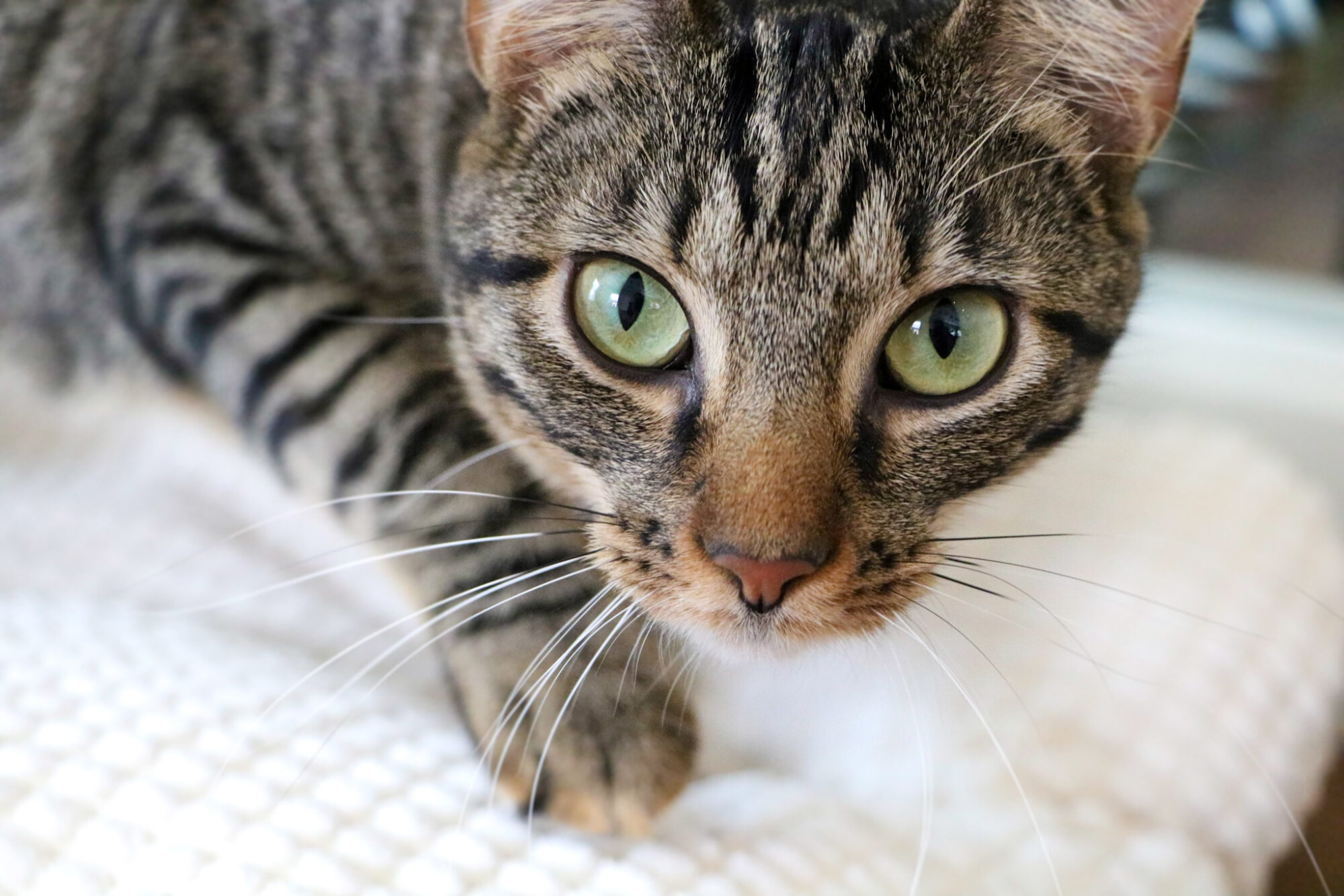
Fabrics, Rugs & Materials to Withstand Everyday Cat-tastrophes
In this post, I’ll share my perspective as an interior designer, cat mom and former cat café owner on the best home décor fabrics and materials for their durability and cleanability. If you haven’t already, I suggest also reading Part 1, where I address ways to enhance and adapt your home for the emotional and physical needs of your cat(s). Getting the material choices right must go hand-in-hand with creating a space that considers your cats’ needs first, because so many destructive behaviors happen when these basic needs aren’t being suitably met in the home.
I’m going to get the bad news out of the way first: no material on earth is cat-proof. But really, no material is truly human-proof either. So, the following suggestions are also appropriate for ANY household, with pets or otherwise. I say that simply to level-set expectations. Furnishing a home with cats means being ready to accept the reality that not everything will stay perfect and pristine. No matter what you do, eventually something will be vomited on, clawed on, or worse. But don’t despair – if you’re a cat lover like me, you can still have a beautiful home, and make it a bit easier on yourself when the inevitable happens.
UPHOLSTERY
Sofas and chairs are usually the first thing we think of as being susceptible to cat damage. Other than providing suitable alternatives like scratching posts, choosing the right fabric is paramount. Some fabric types will be able to withstand the wear and tear much better than others. Here is what to look for, and what to avoid when it comes to upholstery fabrics:
Look for:
Performance Fabrics
For my interior design clients who have cats, dogs or kids, I always recommend performance-grade fabrics for sofas and chairs. Performance fabrics are specially formulated to be durable, cleanable and rugged; they are able to withstand common kinds of wear and tear. The “performance” aspect of these fabrics is achieved due to the textile chemistry of the fibers themselves and/or a coating or backing that is applied to the fabric. They can be made of polyester, acrylic, nylon, or a blend. You can also sometimes find performance fabrics that blend in smaller amounts of natural fiber like cotton or linen. Performance fabrics will often be branded as Crypton®, Nanotex®, or Sunbrella ® (which can be used indoor/outdoor). You will also sometimes see descriptive terms like “soil & stain repellant” or “commercial grade” used to describe these fabrics.
First, I suggest narrowing down your options to only performance fabrics, and then select ones that have the following qualities:
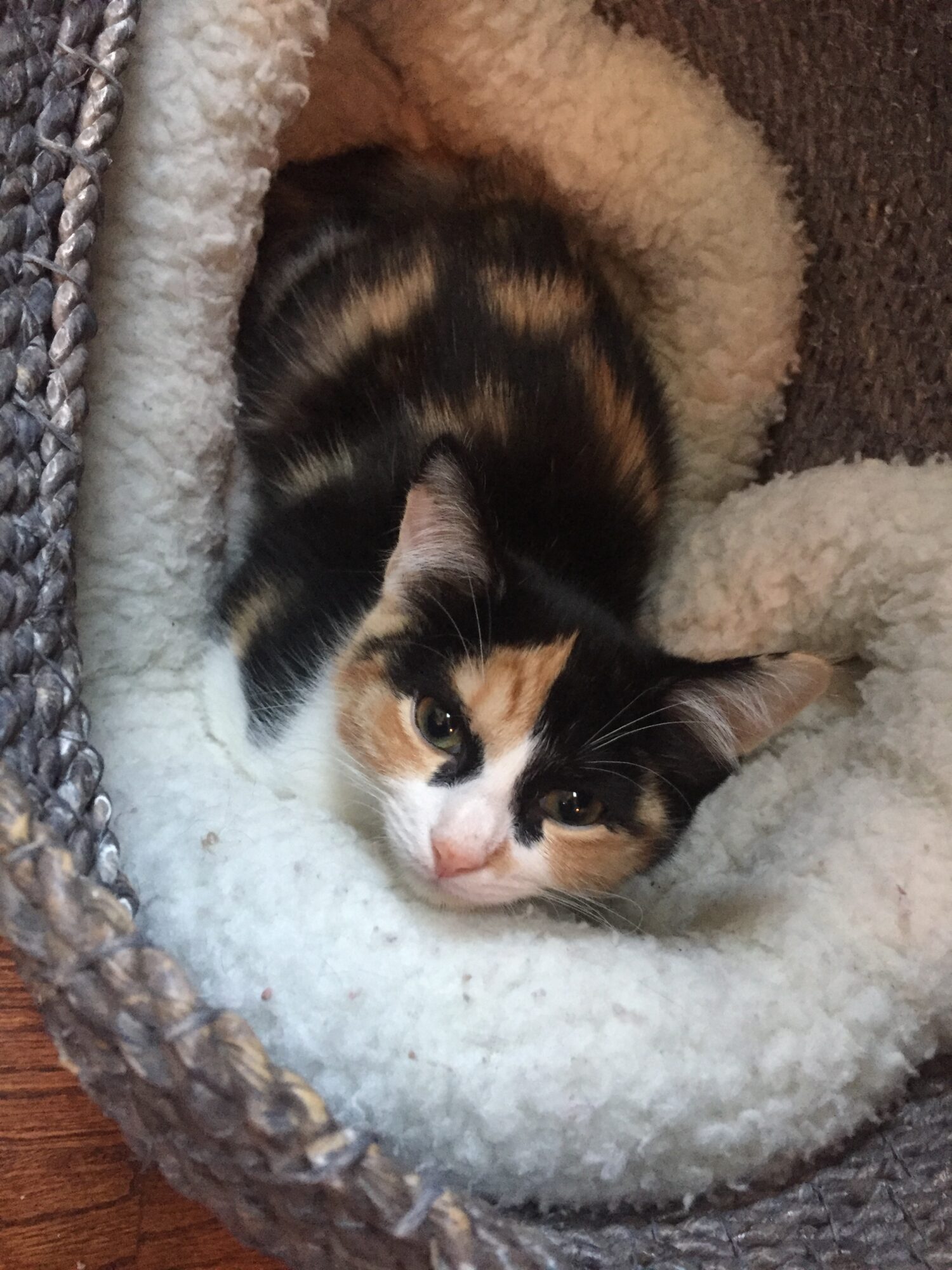
Tight Weaves
Focus on fabrics with a very, very tight weave. The less daylight you can see through a fabric, the denser the weave, which means the less your cat’s claws can snag and pull at the fabric.
Fabric with a Backing
Many but not all performance fabrics are constructed with a textile finish or applied backing. This gives the fabric more strength and helps prevent water or wet soil from penetrating into the upholstery.
Nap-type Fabrics
No, I don’t mean fabrics for taking a snooze, though your cat will see them that way. Fabrics with a nap are ones that have a fuzzy texture like velvet or corduroy. The cut-pile surface of the fabric means there is no place for cat claws to hook into, making these fabrics less likely to snag. On the downside, velvet and corduroy tend to hold into lint and hair, and therefore need more frequent vacuuming.
Patterned Fabrics
Stripes, geometrics, florals and abstract patterns can all be good choices for hiding stains and pet hair. It doesn’t have a to be a large or strong pattern – even just a hint of tonal variation will do the trick much better than a true solid ever could.
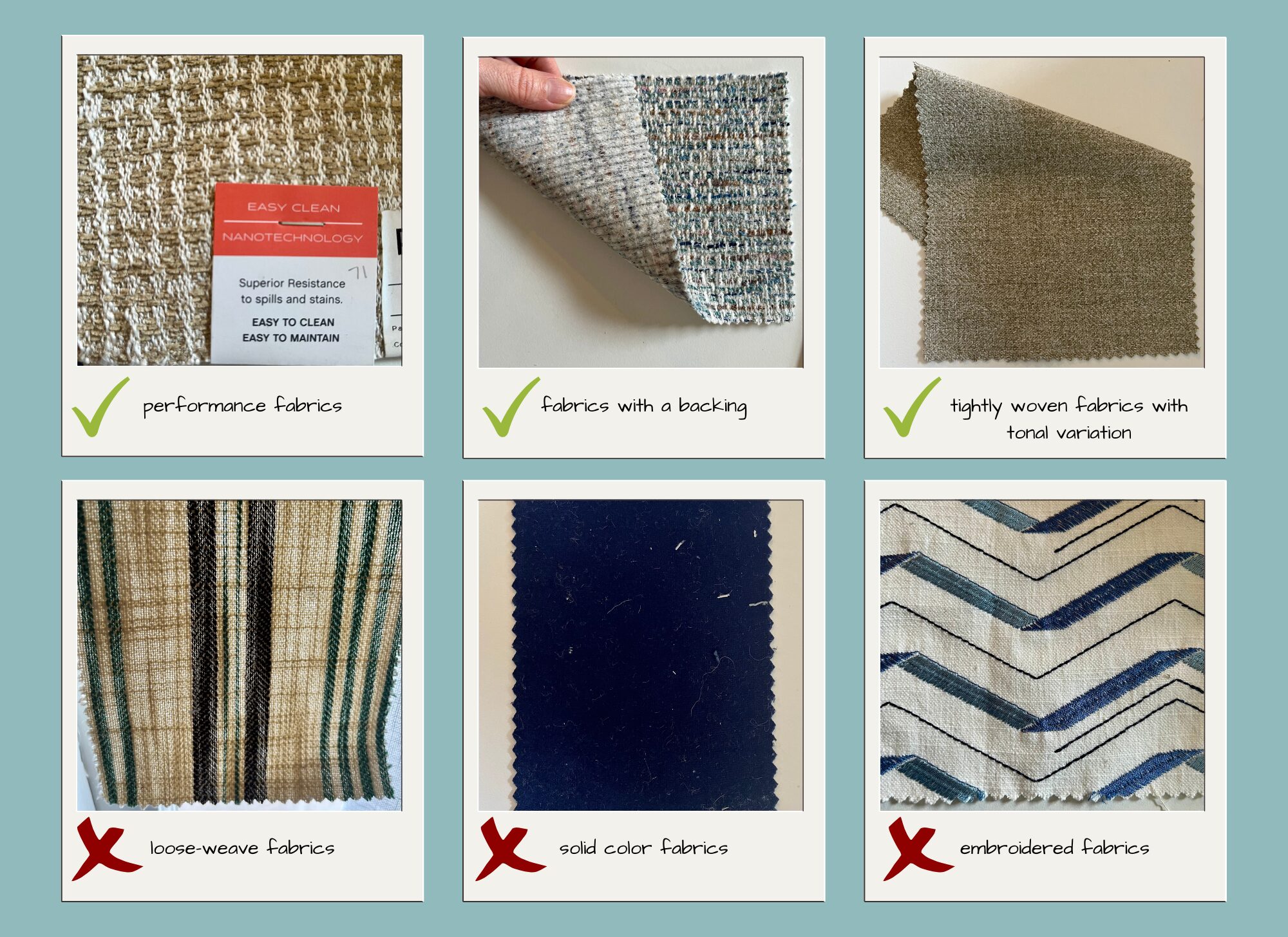
Avoid:
Delicate fabrics
Avoid any fabric that is very lightweight, lacking in structure, or cannot get wet. For this reason, silk, viscose, or blends of these are off the table. Reserve these for accent items like a throw pillow, lampshade, or smaller items you won’t feel so bad about if they get damaged.
Loose Weave Fabrics
Any fabric where you can visibly see through the fabric is too loosely woven to coexist with cats. Embroidered fabrics, or fabrics with long running threads in the pattern are also to be avoided. If you can pull the fabric with your fingernail even a little bit, just think what you cat’s claws could do.
Solids
A true, flat solid fabric will show every bit of lint and pet hair. Any stains that can’t be removed will be much more noticeable.
Leather, with Caveats
Leather MIGHT be a good choice because it is fairly durable, and easy to wipe clean. On the other hand, leather can be scratched up either intentionally or by accident when your cat gets the zoomies and decides it would be fun to parkour off the ottoman. Only you know your cat, so I’d proceed with caution before investing in leather furniture.
What about faux leather or vinyl? This might be an okay choice for the same reasons as leather might be okay. But vinyl can still get scratched up, and when it does it looks even more unsightly than scratched leather. It can’t be buffed out or conditioned like leather, so once the damage is done it’s done
RUGS
Rugs are susceptible to all of the same perils as upholstery, probably even worse. So while I may love them as works of art, I avoid recommending very high-end, artisan or heirloom rugs for my clients who have pets. Instead I lean towards durable, cleanable, stain resistant options that can withstand wear and tear. This is simply an area where I feel practicality outweighs all other considerations. On the plus side, a durable and practical rug is usually MUCH less expensive than an heirloom rug. With the money you save you could get art for the walls, or better yet, some great cat furniture!
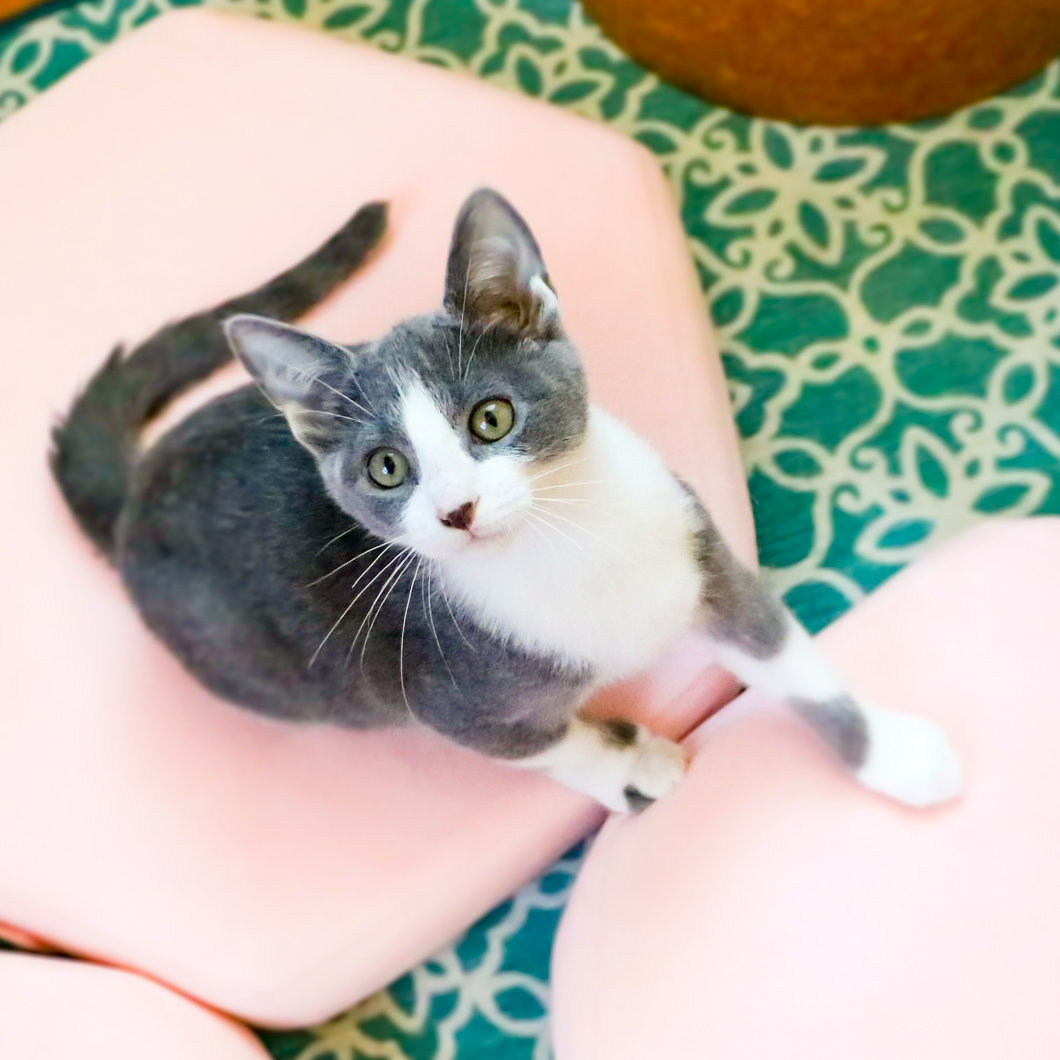
Look for:
Synthetic Fiber Rugs
Durable synthetic rugs are typically made of polyester or solution dyed nylon. These are easiest to clean and maintain, and tend to be quite inexpensive. There are machine-washable options now on the market that I love for pet-friendly households.
Natural Fiber Rugs
Jute and sisal are amazingly hearty natural fibers, and do a great job to disguise any pet stains. Be aware that your cat may treat your jute/sisal rug as a huge horizontal scratching post, which can create a lot of shredded fibers that must be vacuumed up. Fortunately these are also typically very affordable rugs.
100% wool rugs
Wool is very durable and naturally stain and soil repellant. This is usually the option I recommend if my client wants a “nicer” rug that is still fairly practical in a pet household. While more expensive than synthetics, wool rugs tend to last longer assuming they are properly maintained with regular vacuuming and periodic professional cleaning.
Patterned Rugs
Go for rugs with patterns or tonal variations. The more interesting and varied the pattern, the better for camouflaging stains.
Warm Tones
Warm colors or warm neutrals like tan, beige, brown, red, rust, or gold are easiest to maintain. How to put this delicately? The color of the stains that come out of your cat’s body will be masked better by warm tones.
Cut-Pile Rugs
Rugs with a cut pile surface have yarn fibers that stick out from the backing like the bristles of a brush, and are less easily snaggable by cat claws.
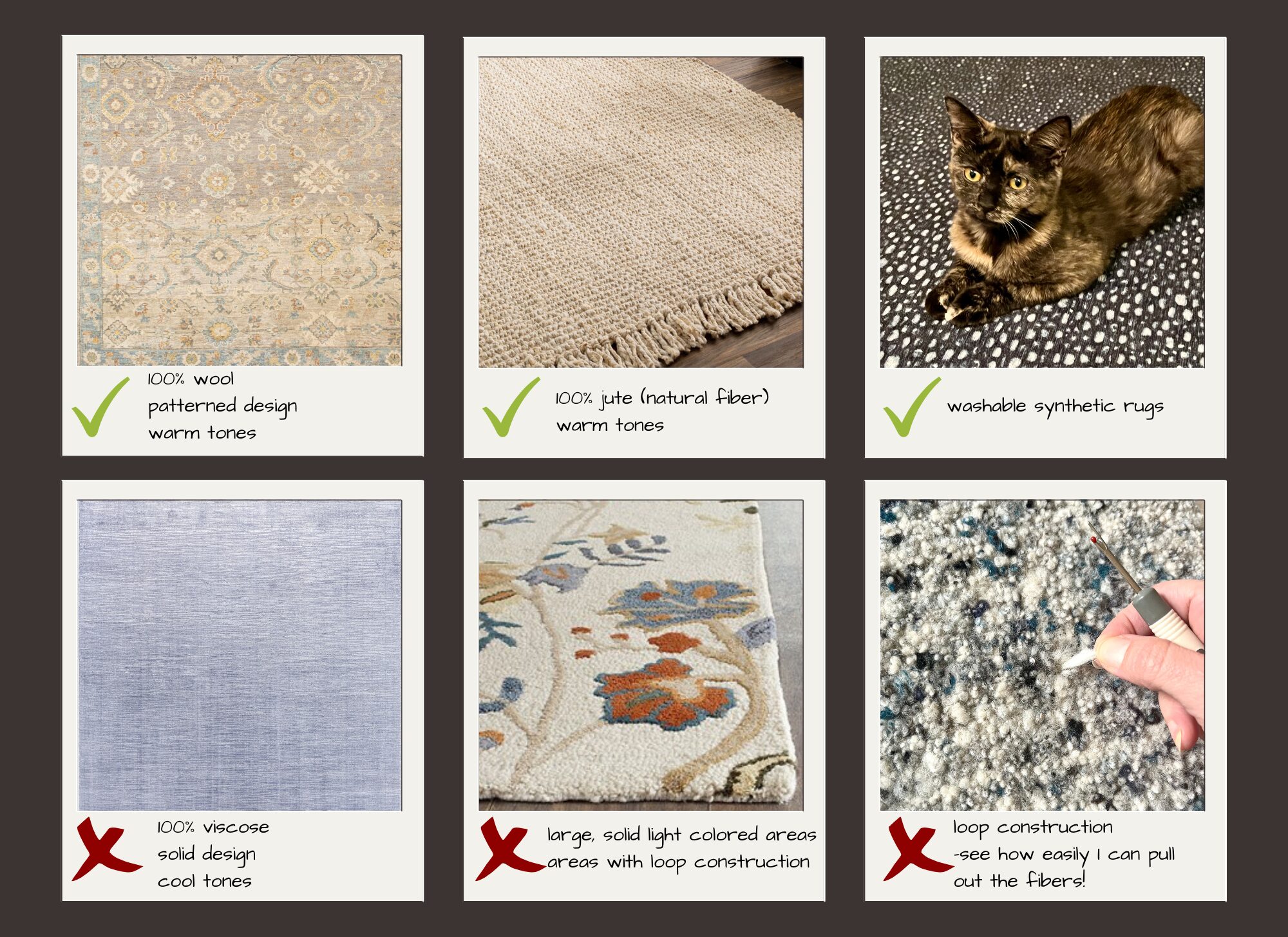
Avoid:
Delicate Fibers
Silk or viscose of any amount in a rug is verboten. I actually avoid these fibers for any household regardless of whether there are pets. They are extremely difficult to maintain and are not durable enough to have any business going on your floor.
Solids
Rugs with large areas of solid color will not mask stains well.
Light/Cool Tones
Rugs that are predominantly light and cool toned, such as light grey, light blue, or white will be harder to keep looking clean, for reasons noted above.
Loop-Pile Rugs
Loop style rugs are made with little loops of yarn that return back into the rug backing. Some rugs are a combination of cut and loop. Looped yarns can get stuck in your cat’s claws and easily be pulled out, so they are to be avoided.
WINDOW TREATMENTS
Windows provide the primo cat entertainment spot in your home, so any window treatments must be chosen with care. Your cat will want to spend many hours looking out the window, watching the birds, and chasing any exciting bugs that happen to land on the glass. I would highly recommend a window treatment solution that can be left open and/or tied up and out of the way during the daytime.
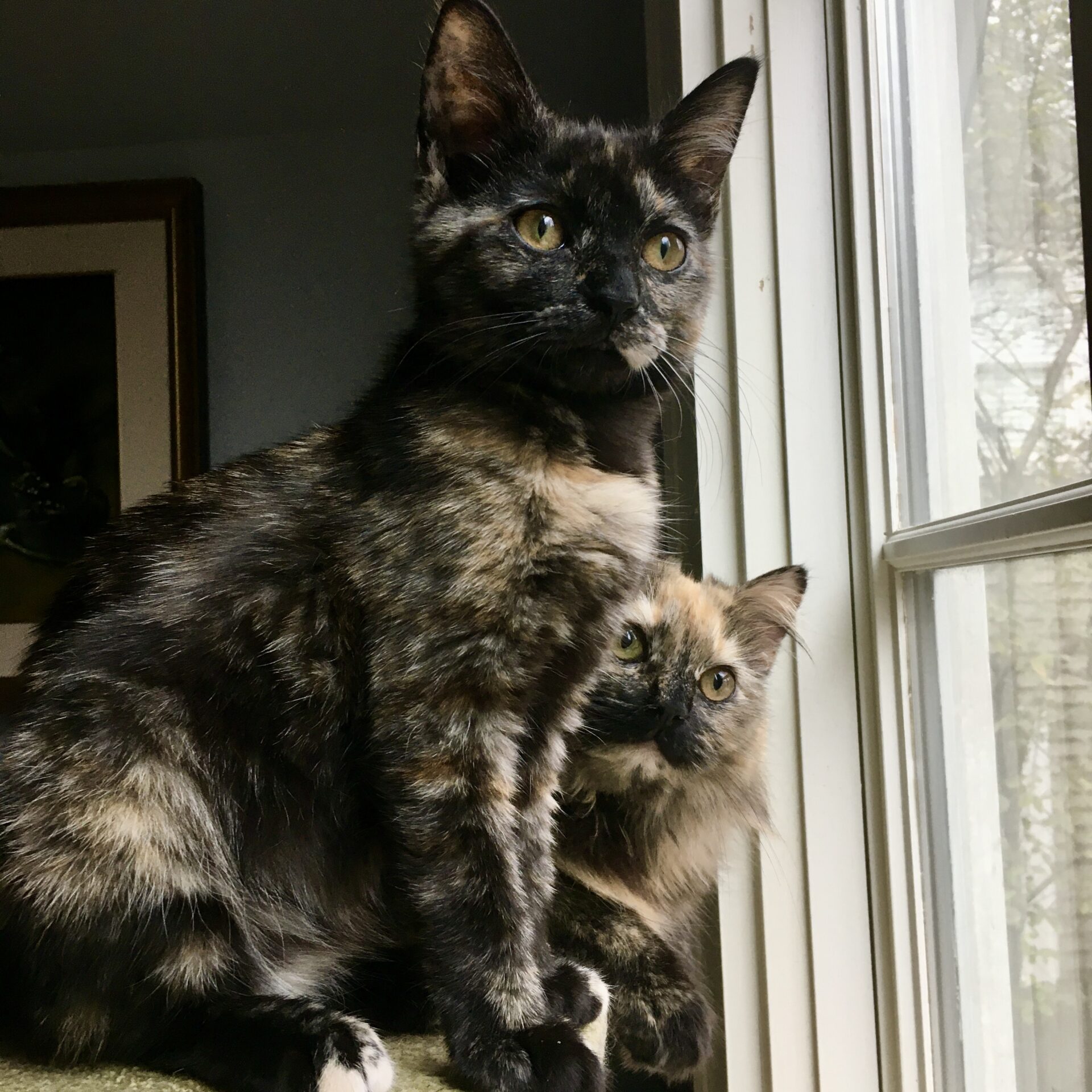
Drapes
Drapes are a bit of a risky prospect if you have cats. They run the risk of being clawed up, climbed on, and peed on (true story*). This is doubly true if you adopt kittens, who look at drapery as a fun climbing challenge. Drapery might best be reserved for households with adult cats or cats with a more placid personality. As far as drapery fabric goes, a lot of the same suggestions as upholstery apply here.
What to look for:
- Fabric with a tight weave will stand up best to any clawing.
- Fabric with patterns or textural variation will help camouflage any stains or small pulls.
- Add a lining to your drapes to give them more structural stability.
- Add a tie-back or hook so your drapes can be pulled out of the way during the day.
What to avoid:
- Airy, floaty fabrics like light weight linen or cotton will snag easily.
- Silk or viscose fibers are much too delicate for cat households and cannot be easily washed.
- Solid colors will more readily show cat hair and stains.
- Steer clear of any dangly bits like pompoms or tassels, unless you want your drapes to look like a giant expensive cat toy.

Shades
Non-drapery options will generally fare a bit better – any kind of shade – roman shades, honeycomb shades, roller shades are usually safer choices than drapes, and less appealing to claw or climb especially if they’re mostly kept open during the day. If you have shades with a dangly string or chain, be sure to keep it tacked up so that it doesn’t become a strangulation risk.
Shutters
Interior window shutters are probably the heartiest choice, and least able to be messed with. Unless you have a cat who likes to chew on things they’ll probably present the least hassle. Again, just keep them open so your cat can keep tabs on the world!
TIPS FOR MAINTENANCE & PREVENTION
Fabric Protection
As soon as your new upholstery arrives, schedule a professional fabric protection treatment. This is applied as a spray, and creates a non-porous coating that prevents water and stains from penetrating into the cushions.
Know Your Fabric Cleaning Codes
Every fabric is assigned a cleaning code, which tells you what methods you can and cannot use to clean it. This is very important information, because some fabrics should not be cleaned with water. If you don’t know your fabric’s cleaning code, you can ask the retailer where you purchased your upholstery.
Clean Messes up Quickly
The more time your pet’s accident has to sit on a fabric, the greater the chance of a permanent stain. Generally speaking, throw-up is easier to deal with than urine. Vomit can be cleaned up (following the fabric manufacturer’s guidelines) just like any other spill or mess. Unfortunately with cats, urine can pose a major problem. Even when cleaned it can leave a lingering scent that draws your cat back to the same spot to use as their “litter box” again. Cats urinate outside the litter box for a number of health and behavioral reasons, so it’s advisable to consult your vet if this is happening. In the meantime, blot up as much of the urine as soon as possible, spread a layer of baking soda over the spot to draw up remaining liquid and neutralize the scent. Then, spray the area with plain diluted vinegar to further neutralize*. I would strongly advise following up with a professional cleaning as soon as possible for both rugs and upholstery.
*Only try this method if you know if to be safe for your fabric.
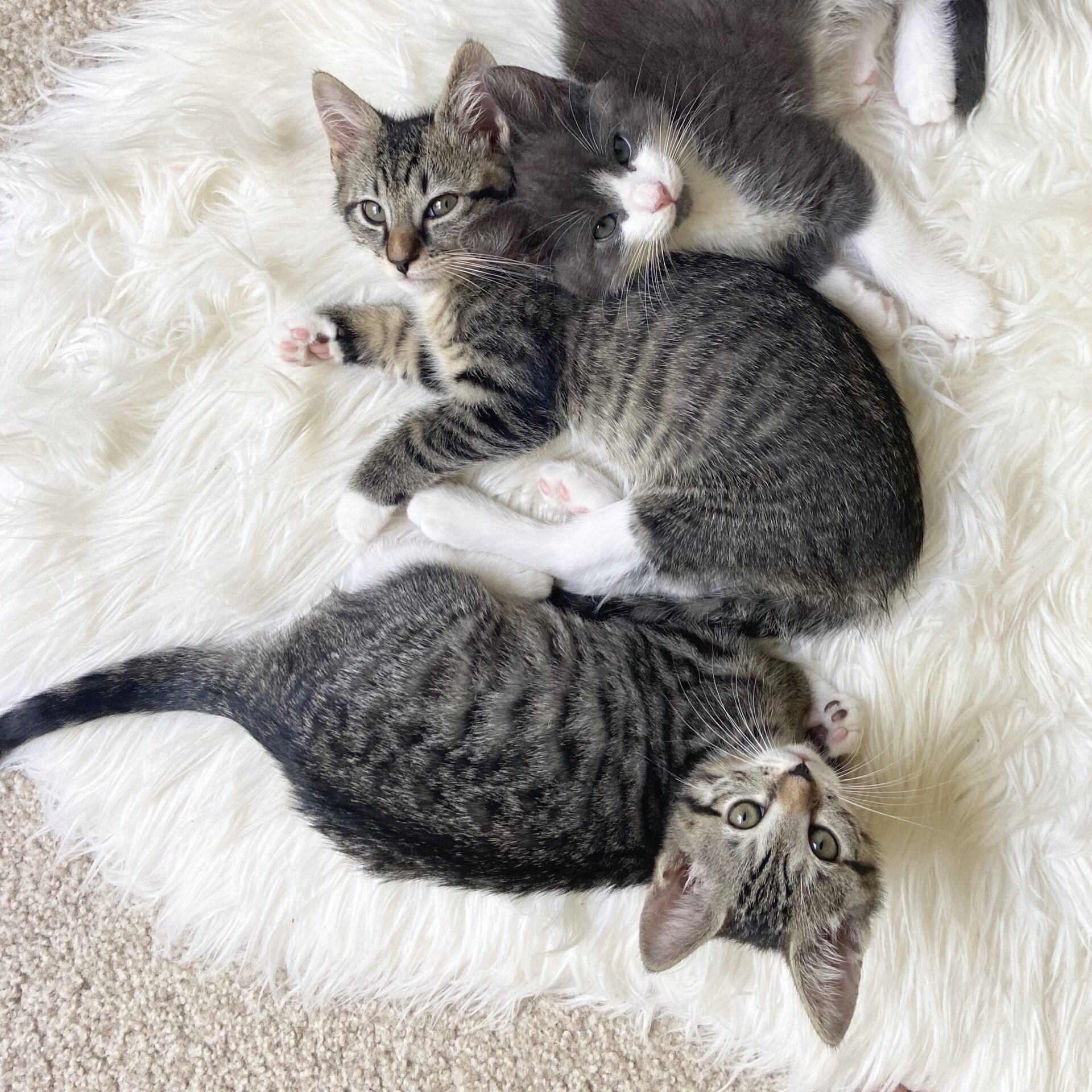
Listen, cats are the cutest little menaces to home décor on earth. Do I feel a tiny pang of sadness when I look at my snagged drapes, my scratched leather chairs, and my stained rug? Yes, yes and yes. Would I trade my furry babies for a perfect, damage-free home? Not for a second. The joy they bring to our home far outweighs the costs.
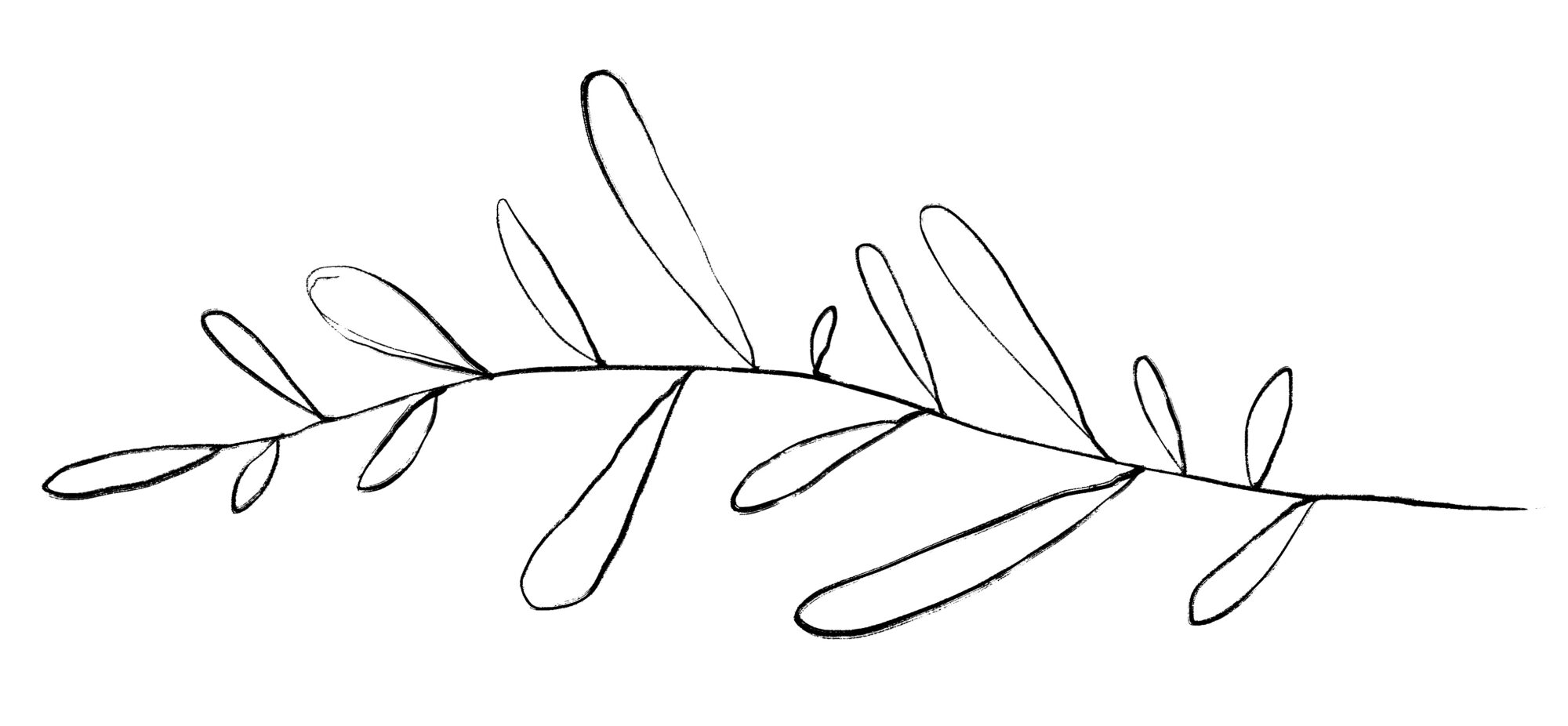
Want personalized, expert guidance to define your Signature Style and implement it in your next home project? Send us a message today!
